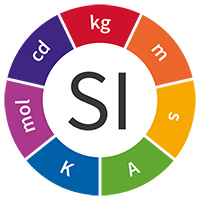Measurement is at the heart of all science and engineering. It is only when we can measure something that scientists can study it and engineers can improve it. Since science and engineering play an important role in our lives, measurement matters for everyone.
Measurement is the quantitative comparison of something against a reference. A measurement result is expressed as a number, or value, together with one or more units of measurement. For example, a car’s speed of 10.4 metres per second is usually written as 10.4 m/s.
When a measured value is given along with its one or more units, this tells us the dimension (such as mass or length or time) and the scale of the measured value.
The science of measurement is called 'metrology'.
Measurement affects our daily lives…
In all these situations, and thousands more, we are enjoying the benefits of a global system of measurement.

But how do we know that ‘one metre’ in the UK is the same as ‘one metre’ in Japan? And how do we ensure that ‘one metre’ today is the same as it was 20 years ago?
We do this by using the globally agreed International System of Units, known as the SI (from the French, Système International d’Unités). The SI sets out what the agreed units of measurement are, how they are defined and how they are realised in practice.
The widespread adoption of the SI allows science, industry and trade to measure physical objects and phenomena using the same units, so that the results can be compared meaningfully, worldwide.
The SI was formally agreed in 1960 and is directed from the International Bureau of Weights and Measures (BIPM), a laboratory situated in diplomatically-protected territory in Sèvres, just outside Paris. At BIPM, scientists from all over the world meet to agree upon definitions of precisely what we mean by each of the SI base units. Typically, these scientists work at national measurement institutes which have responsibility for making the benefits of the SI available within individual countries. In the UK, this is one of the key roles of the National Physical Laboratory.
A Beginner’s Guide to Measurement
This is ideal for those that are new to measurement. It provides an introduction to metrology, the science of measurement.
Part One provides an overview and history of measurement and explains the fundamental concepts and basic facts about the world of measurement. Part Two provides more practical information that affect many areas of measurement and explains why measurement issues should be addressed.
Beginner's guide to measurement in mechanical engineering GPG131
A Beginner’s Guide to Uncertainty of Measurement
This guide is an introduction to uncertainty of measurement for beginners, including laboratories preparing for UKAS accreditation.
It explains the concept and importance of measurement uncertainty, using examples from everyday life. It illustrates how to estimate uncertainties in real measurement situations, showing a detailed uncertainty calculation step by step.